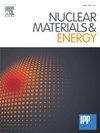Determination of tritium inventory in carbon divertor tiles used in deuterium plasma experiment by induction heating method
IF 2.3
2区 物理与天体物理
Q1 NUCLEAR SCIENCE & TECHNOLOGY
引用次数: 0
Abstract
The tritium inventory of the plasma-facing materials in a Large Helical Device (LHD) was analyzed using a thermal desorption system. In this study, we developed an induction heating system for the thermal desorption of tritium from carbon divertor tiles, which has several advantages, including a rapid temperature rise, internal heating via eddy currents, and heating with the original size and shape of the carbon tile. The apparatus was capable of heating a carbon divertor tile to a temperature greater than 1373 K over 20 min. Following a 12-h heating period at 1423 K, the tritium release rate from the carbon tile was 99.7 %. The chemical form of the tritium released from the divertor tiles was approximately 80 % molecular hydrogen, with the remaining tritium in the form of water vapor. The results of the tritium analysis of the divertor tiles suggest that the tritium distribution in the divertor region is not uniform, and that the flux varies from location to location in the LHD. To improve the accuracy of the tritium inventory analysis in an LHD vacuum vessel, it is essential to conduct a tritium inventory analysis of other plasma-facing materials.
求助全文
约1分钟内获得全文
求助全文
来源期刊

Nuclear Materials and Energy
Materials Science-Materials Science (miscellaneous)
CiteScore
3.70
自引率
15.40%
发文量
175
审稿时长
20 weeks
期刊介绍:
The open-access journal Nuclear Materials and Energy is devoted to the growing field of research for material application in the production of nuclear energy. Nuclear Materials and Energy publishes original research articles of up to 6 pages in length.
 求助内容:
求助内容: 应助结果提醒方式:
应助结果提醒方式:


